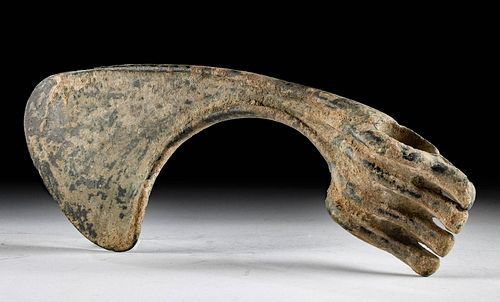Luristan Bronze Axe Head w/ Ribs
Lot 41
About Seller
Artemis Fine Arts
686 S Taylor Ave, Ste 106
Louisville, CO 80027
United States
Selling antiquities, ancient and ethnographic art online since 1993, Artemis Gallery specializes in Classical Antiquities (Egyptian, Greek, Roman, Near Eastern), Asian, Pre-Columbian, African / Tribal / Oceanographic art. Our extensive inventory includes pottery, stone, metal, wood, glass and textil...Read more
Estimate:
$600 - $900
Absentee vs Live bid
Two ways to bid:
- Leave a max absentee bid and the platform will bid on your behalf up to your maximum bid during the live auction.
- Bid live during the auction and your bids will be submitted real-time to the auctioneer.
Bid Increments
| Price | Bid Increment |
|---|---|
| $0 | $25 |
| $300 | $50 |
| $1,000 | $100 |
| $2,000 | $250 |
| $5,000 | $500 |
| $10,000 | $1,000 |
| $20,000 | $2,500 |
| $50,000 | $5,000 |
| $100,000 | $10,000 |
| $200,000 | $20,000 |
About Auction
By Artemis Fine Arts
Nov 12, 2020
Set Reminder
2020-11-12 12:00:00
2020-11-12 12:00:00
America/New_York
Bidsquare
Bidsquare : Arms & Armor | Antiquity to Modern Day
https://www.bidsquare.com/auctions/artemis-gallery/arms-armor-antiquity-to-modern-day-6023
Specialty auction featuring axes, mace heads, swords, spears, various types of armor, and more! Many different cultures and price ranges. Great for first-time buyers, seasoned collectors, dealers, and that hard to buy for person on your holiday shopping list. Artemis Fine Arts info@artemisfinearts.com
Specialty auction featuring axes, mace heads, swords, spears, various types of armor, and more! Many different cultures and price ranges. Great for first-time buyers, seasoned collectors, dealers, and that hard to buy for person on your holiday shopping list. Artemis Fine Arts info@artemisfinearts.com
- Lot Description
Ancient Near East, Northwestern Iran, Luristan, ca. 1000 to 600 BCE. A cast bronze axe head with a dramatically curved blade that widens to a broad cutting edge. The socket is narrow and tubular with four encircling ribs that protrude from the butt end of the axe. While the curved blade could cut, the blunt butt end could deal some nasty blows as well. The axe was made using the lost wax technique which was a popular method for Luristan craftsmen to make these iconic weapons. Size: 7" L x 2.6" H (17.8 cm x 6.6 cm)
Spike-butted axes have been excavated from graves at Bard-I Bal, Kutal-I Gulgul, and Khatunban, all in the Luristan region, but two found with inscriptions from, respectively, an Elamite king and a Babylonian king, have led researchers to believe that the style may have originated in Mesopotamia and been brought to Luristan. The function of these axes is unclear - large examples like this one and one held by the British Museum (Accession Number 130676) have thick, blunt blades that are often at too sharp an angle from the socket to have ever been used as cutting tools. However, if they were hafted onto curved shafts, they could have been swung back and forth, using the spikes like a mace, and the blunted blade to pierce armor. They may also have been heirlooms, royal regalia, or even made to be grave goods.
Provenance: ex-estate of Eldert Bontekoe, Pegasi Numismatics, Ann Arbor, Michigan, USA acquired before 2000
All items legal to buy/sell under U.S. Statute covering cultural patrimony Code 2600, CHAPTER 14, and are guaranteed to be as described or your money back.
A Certificate of Authenticity will accompany all winning bids.
We ship worldwide and handle all shipping in-house for your convenience.
#158939Minor nicks and surface abrasions. Earthen encrustations and mineral deposits. Intact!Condition
- Shipping Info
-
All shipping is handled in-house for your convenience. Your invoice from Artemis Gallery will include shipping calculation instructions. If in doubt, please inquire BEFORE bidding for estimated shipping costs for individual items.
-
- Buyer's Premium



 EUR
EUR CAD
CAD AUD
AUD GBP
GBP MXN
MXN HKD
HKD CNY
CNY MYR
MYR SEK
SEK SGD
SGD CHF
CHF THB
THB














